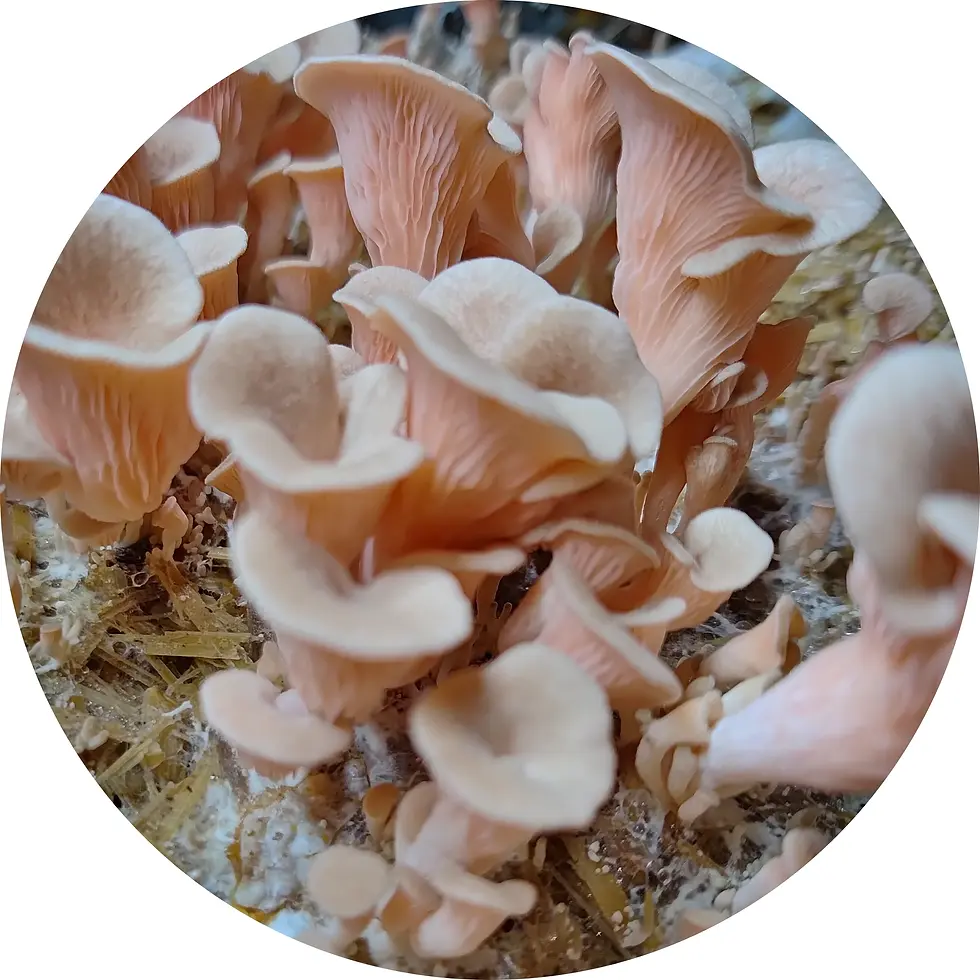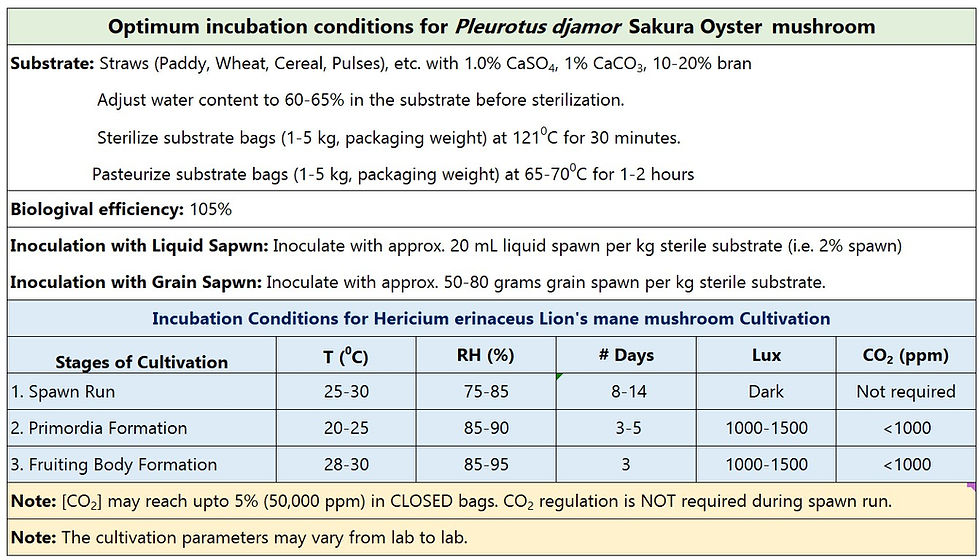How to Grow Pleurotus Djamor Mushrooms Effectively
- Neeraj Kumar

- Jun 30
- 4 min read
Growing mushrooms can be a fascinating and rewarding experience, especially when it comes to the beautiful pink oyster mushroom (Pleurotus djamor). These mushrooms are not only stunning in appearance but also a delicious addition to various dishes. In this blog post, we will explore how to grow Pleurotus djamor mushrooms effectively, ensuring you have a bountiful harvest.
Pink Oyster Mushroom Farming
When considering mushroom cultivation, understanding the specific requirements for growing pink oyster mushrooms is crucial. Pleurotus djamor thrives in warm, humid environments. Initial temperatures should range from 20°C to 30°C (68°F to 86°F).
Proper humidity is essential for the development of these mushrooms. An environment that is too dry can hinder growth, while excessive moisture can lead to contamination. Aim for a humidity level of around 85-90% during the fruiting phase to encourage thriving mycelium.
To start, you will need mushroom spawn. This can be purchased from reputable suppliers or made at home using a suitable substrate. Common substrates include straw, sawdust, or even coffee grounds. Make sure to pasteurize the substrate to eliminate competing organisms.
Once you have your substrate ready, mix in the spawn at the recommended rate. Then, place the mixture into containers such as bags or jars, sealing them to maintain humidity. Store these containers in a warm and dark environment until mycelial growth is observed—this could take 1 to 2 weeks.

The next phase involves exposing the mycelium to fresh air and light to encourage pinning, the process where mushrooms begin to form. This usually happens when the temperature drops slightly and there is an increase in oxygen and light. Mist the areas lightly to maintain humidity but avoid over-saturation.
Ideal Growing Conditions for Pleurotus djamor
To successfully grow Pleurotus djamor mushrooms, you must create the ideal growing conditions. Here are some key factors to consider:
Temperature: Ideal temperatures for growing these mushrooms range from 25°C to 30°C (76°F to 86°F). However, they can tolerate a broader range of temperatures, but growth might be slowed.
Humidity: As mentioned earlier, maintaining high humidity (around 85-90%) is crucial during fruiting. Use a hygrometer to monitor moisture levels accurately.
Light: While Pleurotus djamor does not require direct sunlight, they do benefit from indirect light. A 12-hour light/dark cycle can encourage healthy growth.
Airflow: Proper ventilation is essential to prevent the buildup of CO2, which can stifle mushroom growth. Ensure there is adequate airflow in the growing area.
Substrate: Using a nutritious substrate rich in carbon, such as straw, helps provide the essential nutrients for the mushrooms.
By keeping these conditions in mind, you can cultivate a flourishing crop of pink oyster mushrooms.

Is Pleurotus djamor Poisonous?
One of the fascinating aspects of mushrooms is understanding which is edible and which are not. Fortunately, Pleurotus djamor is not poisonous and is considered safe for consumption. This species is known for its mild flavor and tender texture, making it a popular choice for culinary applications.
However, as with any mushroom, ensure proper identification before consuming. It is vital to be aware that some wild mushrooms can be toxic, and always opt for cultivated varieties when in doubt.
Benefits of Growing Pink Oyster Mushrooms
Growing Pleurotus djamor has various benefits, both for home gardeners and commercial growers. Here are a few reasons to consider adding these stunning mushrooms to your cultivation efforts:
Fast Growth Cycle: Pink oyster mushrooms have a relatively short growth cycle compared to other species, allowing for quicker harvests.
High Yield: When conditions are optimal, growers can expect significant yields, with several flushes possible from a single substrate batch.
Nutritional Value: These mushrooms are packed with nutrients, including proteins, vitamins, and minerals. They can be a healthy addition to an array of dishes.
Eco-Friendly: Growing mushrooms can be a sustainable practice. They can utilize agricultural waste products such as straw and sawdust, turning them into valuable food sources.
Culinary Versatility: The pink oyster mushroom’s unique flavor and texture make it a pleasing ingredient in various recipes, from stir-fries to soups.
Employing these benefits could enhance your gardening experience while leading to delicious culinary adventures.

Troubleshooting Common Issues
While growing Pleurotus djamor can be rewarding, you may encounter some common issues. Here are a few potential problems alongside recommendations for resolving them:
Contamination: This is one of the most common issues in mushroom cultivation. Ensure all equipment and substrates are sterilized before use. If contamination is suspected, remove the affected substrate immediately.
Poor Pinning: If your mushrooms are not forming properly, it could be due to insufficient humidity or lack of airflow. Adjust your environment by increasing ventilation and ensuring moisture levels are maintained.
Slow Growth: If fungal growth appears stunted, check the temperature and humidity levels. If they are lower than ideal, make necessary adjustments.
Pest Infestations: Keep an eye out for pests like gnats or mold. Introduce biological controls if needed, and ensure any organic materials used are clean.
By staying vigilant and proactive, you can mitigate these issues and enjoy a successful growing experience.
Final Thoughts
Cultivating Pleurotus djamor mushrooms can be a fulfilling endeavor, enriching both your diet and home with vibrant flavors and textures. With the right approach and conditions, you can enjoy a steady supply of these delightful mushrooms.
Don't hesitate to explore various growing setups, substrates, and techniques to find what works best for you. Whether you're a novice or an experienced grower, the journey of mushroom farming can lead to delightful results and culinary creations. For additional resources and tips, consider visiting Agripie, where you can discover more about this exciting hobby. Happy growing!




Comments